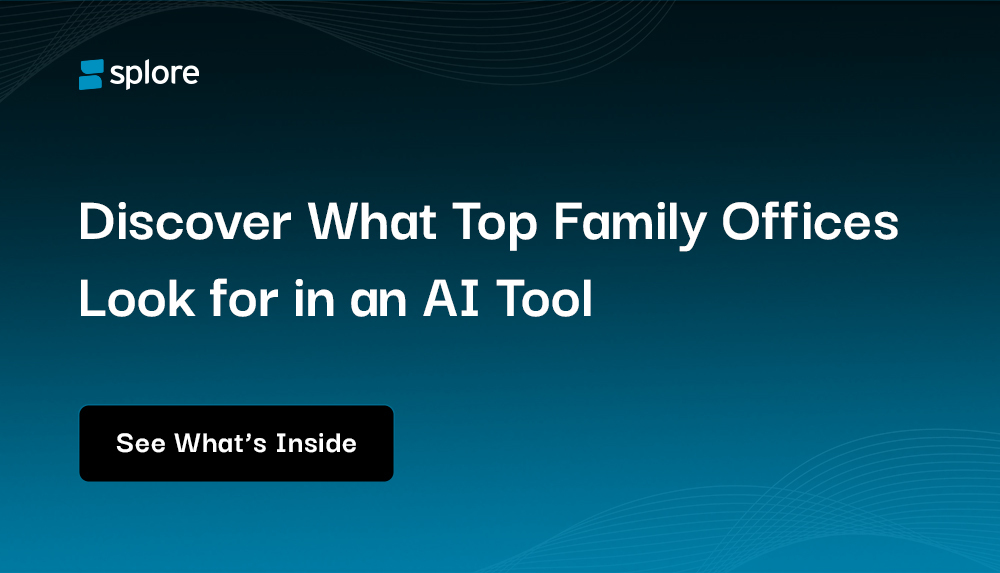Family offices manage a wide range of assets and face challenges like data fragmentation, manual processes, and delayed decision-making. AI tools help solve these problems by automating tasks, consolidating investment data, providing real-time insights, and detecting risks early. This blog explains what features to look for in an AI solution, such as security, integration, customization, and cost-efficiency, to support better investment management and long-term success. (A Free Checklist is Included to Help You Decide)

Choose the Right AI Tool for Family Offices
Managing generational wealth is complex. This free checklist helps family offices pick the ideal AI tool to streamline operations, improve ROI, and simplify data integration.
- Personalized investment reporting
- Automated compliance & risk alerts
- Portfolio optimization with AI
- And more!
Download Free
All fields are required.
Managing a family office means handling different types of assets, reports, and long-term goals. Many still rely on manual tools, which can lead to delays, errors, and missed opportunities.
AI can help simplify the process. It brings all your data together, automates routine tasks, and gives real-time insights to make smarter decisions. But choosing the right AI tool isn’t always easy.
That’s why we’ve put together a clear, step-by-step checklist to help you pick the best solution. You can read the full blog to understand what matters most and download the checklist to guide your decision.
Let’s get started.
Why Family Offices Are Turning to AI
Managing family wealth is a balancing act. With diverse portfolios and stakeholders to satisfy, the pressure is real. Add manual processes and scattered data to the mix, and it’s no surprise family offices are seeking better solutions.
Let’s Look at Some of the Common Challenges:
Managing a family office comes with unique complexities that go far beyond typical investment firms. With varied assets, growing generational needs, and outdated systems, these challenges can slow performance and increase risk.
Here are three of the most common roadblocks:
- Managing Diverse Assets Across Generations
Family offices often manage everything from real estate and private equity to art, collectibles, and philanthropic investments. Each family member may require different reports, goals, and levels of control. Coordinating across these needs while tracking everything manually creates unnecessary complexity.
Key issues include:
- Tailored reporting required for each family member
- Complex tax and estate planning scenarios
- Differing risk appetites and preferences
- Fragmented platforms for tracking diverse investments
- Coordination required for shared and separate assets
- Data Fragmentation and Lack of Unified Visibility
Data scattered across spreadsheets, platforms, and emails slows down decision-making. Without a central view, it’s hard to catch trends, assess performance, or act quickly on market shifts. This fragmented approach increases errors and weakens strategy.
Common symptoms include:
- Spreadsheets managed in silos
- No centralized view across investments
- Manual errors in reporting
- Difficulty syncing with market data sources
- Delays in identifying underperforming assets
- Manual Processes Slow Decision-Making
Many family offices still rely on outdated tools and workflows, making it hard to move quickly. Tasks like reconciliation, report creation, and forecasting often require hours of effort. As a result, opportunities may be missed and operations struggle to scale.
Operational bottlenecks include:
- Time-consuming reconciliation processes
- Delayed risk alerts
- Inaccurate performance reports
- Poor forecasting models
- Limited scalability for growing needs
How AI Simplifies Wealth Management for Family Offices?
AI, in fact, is the behind-the-scenes engine powering smarter, faster decisions in family offices. Instead of relying on manual processes and gut instinct, AI brings clarity, speed, and strategic insight to the table.
Let’s look at how AI makes wealth management easier and more efficient:
- Consolidated Investment Views
Family offices often manage multiple asset classes across generations. AI centralizes everything into one dashboard so decision-makers can see the full picture instantly. This helps improve performance tracking and make quicker, smarter choices.
Key benefits include:
- Aggregated views of real estate, equities, private equity, and more
- Ability to filter data by family member, entity, or asset type
- Faster performance benchmarking across portfolios
- Real-time tracking of assets and changes
- Integrated data from both public and private markets
- Automated Portfolio Insights
AI takes the guesswork out of investing by analyzing patterns, behaviors, and market data. Instead of static reports, you get continuous feedback and suggestions tailored to your strategy. This leads to better decisions and reduced risk.
Look for features like:
- Predictive modeling based on real-time market signals
- Insights generated from past investment behavior
- Alerts when assets underperform or deviate from goals
- Machine learning that adapts strategies over time
- Personalized recommendations for each family profile
- Proactive Risk Detection
In traditional setups, risk is often caught too late. AI changes that by spotting red flags before they become serious issues. With advanced risk modeling, family offices can act early and stay ahead.
AI-powered risk tools should offer:
- Real-time detection of unusual behavior or anomalies
- Predictive analytics that forecast potential market shifts
- Sophisticated models for assessing portfolio-level risk
- Early alerts for possible fraud or security breaches
- Smart flagging to support compliance and governance
What Are the General Features Every Family Office AI Tool Must Have?
Before you choose any AI tool for your family office, it’s essential to get the basics right. These foundational features ensure the platform is reliable, secure, and adaptable to your evolving needs.
Let’s take a closer look at the must-haves:
- Security & Compliance
Security is a must in financial environments. The right AI tool must protect sensitive data and help you meet all relevant regulations. This protects your firm from legal risks and builds long-term trust.
Check for:
- Compliance with global standards (SEC, GDPR, FINRA)
- End-to-end data encryption for secure access
- Real-time audit logs for full transparency
- Automated compliance tasks to reduce manual errors
- Built-in fraud detection to catch anomalies early
- Automation & AI Capabilities
Automation saves time, while AI delivers smarter insights. Together, they help reduce manual errors and improve investment decisions. A strong AI tool will not only analyze but also act intelligently.
Look for tools that:
- Reduce human error in portfolio management
- Offer insights driven by machine learning
- Automate repetitive tasks and workflows
- Suggest dynamic asset allocation strategies
- Predict market changes with intelligent forecasting
- Integration & Compatibility
Your AI tool should work well with the systems you already use. Whether it’s your CRM, accounting software, or data sources, seamless integration is critical. This ensures smoother workflows and fewer data bottlenecks.
Ensure the tool:
- Integrates with popular CRMs and financial systems
- Supports Bloomberg, Reuters, and API connectivity
- Works across mobile and desktop devices
- Allows customizable dashboards for specific needs
- Syncs data reliably across cloud platforms
- Usability & Scalability
Even the most powerful tool is useless if no one can figure out how to use it. The platform should be easy to learn and scale as your family office grows. This makes adoption easier and future expansion smoother.
Check if the AI solution:
- Has a user-friendly interface with minimal learning curve
- Includes built-in training materials and knowledge base
- Handles large transaction volumes without delays
- Offers cloud-based infrastructure for easy scalability
- Supports multiple users with different permission levels
- Cost & ROI Considerations
It’s not just about what the tool costs, it’s about the value it brings. A good AI tool should improve efficiency, save time, and boost returns. Transparent pricing and flexibility are also key to long-term satisfaction.
Be sure the tool offers:
- Clear, tiered pricing with no hidden fees
- Built-in automation that saves time and money
- Measurable ROI through improved performance
- A free trial or sandbox for testing before purchase
- Flexible plans for offices of different size
What Top Family Offices Know About AI Tools (and You Should Too)
Download Free
All fields are required.
What Are the Prime Features Every Family Office AI Tool Must Have?
Now, let’s dig deeper into what truly matters for family offices. These aren’t just nice-to-have features, they’re critical for effective, long-term AI-powered investment management.
- Consolidated Multi-Asset Data Integration
Family offices manage a wide range of assets from real estate and private equity to hedge funds. A powerful AI tool should bring all of this data into one place for easy access. This simplifies decision-making and ensures a more accurate investment picture.
Look for tools that offer:
- Unified dashboards for all asset classes
- Tracking for real estate, PE, VC, and hedge funds
- Support for data-driven investing decisions
- Syncing with custodians and banking platforms
- Elimination of manual data entry errors
- AI-Driven Cost Optimization Suggestions
High fees and inefficiencies can eat into returns without warning. AI tools should analyze costs across all managers and asset types to uncover hidden inefficiencies. This leads to better allocation decisions and improved overall performance.
Prioritize tools that can:
- Identify fee leakage and inefficiencies
- Suggest restructuring for private equity holdings
- Track expense ratios across fund managers
- Alert you to portfolio over-concentration
- Provide AI-backed portfolio analysis
- Customizable Dashboards for Different Family Members
Each family member may have different goals and visibility needs. The AI platform should allow for role-based access and personalized dashboards. This promotes transparency while respecting privacy and decision-making authority.
Must-have capabilities include:
- Personalized views for each user
- Role-based data access control
- Custom KPIs and goal tracking
- Easy-to-understand visualizations
- Built-in tools for internal communication
- Automated Recurring Reports and Payments
Manual reporting eats up time and increases the chance of errors. A solid AI tool should automate key back-office tasks like report generation and payment scheduling. This frees your team to focus on high-value strategy instead of admin work.
Choose a platform that can:
- Generate monthly or quarterly investment reports
- Automate scheduled payments and distributions
- Sync seamlessly with accounting software
- Reduce dependency on back-office operations
- Lower overall compliance and reporting risks
- Advanced Asset Allocation and Cash Flow Visualization
Seeing your current allocations is one thing, planning for the future is another. AI should help you forecast liquidity, plan cash flows, and adjust asset mixes based on changing goals. This results in stronger, more agile investment strategies.
Ensure your AI platform offers:
- Smart rebalancing suggestions based on real-time data
- Cash flow projections by family member or entity
- Visual mapping of asset allocation
- Predictive planning for liquidity needs
- Integration with alternative data sources for deeper insight
What Are the Risks of Choosing the Wrong AI Tool?
One wrong AI tool can do more harm than good. It can slow down operations, create confusion, and limit your ability to grow. Worse, fixing the mess later often costs more time and money than choosing the right solution from the start.
Let’s explore the common traps to avoid:

- Data Silos That Remain Unsolved
When data lives in separate systems, your team wastes hours trying to pull it all together. This leads to inconsistent reporting and missed opportunities. A lack of unified visibility also makes collaboration harder across departments.
Here are the typical signs of poor data integration:
- Multiple platforms that don’t talk to each other
- Disconnected reports per asset class
- Lost time in consolidating data
- Poor communication between advisors
- Over-Automation Without Human Oversight
Too much automation without control can create more problems than it solves. If the AI lacks transparency, you won’t know why decisions were made or if they’re even correct. Human judgment still matters, especially for nuanced family goals.
Watch out for these signs of unchecked automation:
- AI decisions lacking context
- Reduced visibility into changes
- Confusion over data origins
- Hidden Costs and Steep Learning Curves
Some AI tools look affordable at first but hide costs in setup, integrations, or training. What’s worse, if the system is hard to use, adoption across your office will stall. This adds frustration and delays the benefits you were hoping for.
Here’s what to check for before you commit:
- Expensive onboarding
- Additional charges for integrations
- Delays in adoption
- Inflexible Models That Fail to Respect Family-Specific Goals
Not all family offices are the same, and your AI tool should reflect that. A rigid platform won’t adapt to unique structures, legacy preferences, or personalized reporting needs. Without flexibility, the tool works against your goals, not with them.
Here are signs your AI lacks personalization:
- One-size-fits-all dashboards
- No room for legacy structures
- Misaligned reports
Splore: #1 Gen AI Platform Built for Family Offices
Splore is the go-to AI platform for family offices who want clarity, control, and smarter decision-making.
Splore helps track investments, manage alternative assets, and gain real-time insights without the manual workload.
Key Features of Splore:
- Centralized Investment Dashboard
Splore brings all your investments, real estate, private equity, public markets into one unified dashboard. This eliminates the need to toggle between platforms and offers complete visibility in real time.
- Automated Portfolio Insights
The platform uses AI to track performance metrics, spot trends, and generate instant insights. This allows family offices to make data-driven decisions quickly and with greater confidence.
- Predictive Risk Detection
Splore's AI scans for anomalies and uses predictive models to flag risks before they escalate. This helps you act proactively and reduce exposure to unforeseen market changes.
- AI-Generated Custom Reports
You can generate tailored reports with just a few clicks, saving hours of manual work. These reports are visually engaging and built to meet stakeholder expectations with precision.
What Top Family Offices Know About AI Tools (and You Should Too)
Download Free
All fields are required.
Final Thoughts
By choosing the right AI-powered platform, you can future-proof your family office, streamline operations, and focus on long-term wealth strategies. Don’t settle for generic solutions, invest in family office AI tools that understand your complexity. The right tool is essential for smarter, faster, and more secure investment management.
Want to simplify your portfolio strategy and enhance your returns?
Download the checklist. Book a demo with Splore. Make the smarter move.

Download Free
All fields are required.





